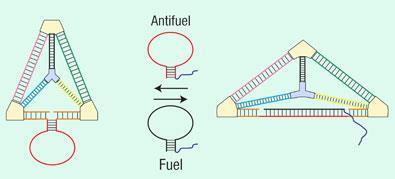Dynamic structures could be drug-delivery vessels
UK and German scientists have designed dynamic DNA cages which expand or contract on demand - and could be used to deliver drugs, or be the moving parts of nanomachines.
Researchers working with DNA have coaxed the strands into various impressive structures over the last two decades - including cubes, prisms, tetrahedra, and other exotic polyhedra. But these have usually been rigid and static: each edge consisting of a short double-stranded DNA segment.
But now, researchers based at the Universities of Oxford and Bielefield have built tetrahedra with one unusual edge that includes a single-stranded segment of DNA in its middle section[1]. This segment normally bunches up into a hairpin structure, but it straightens out - thus lengthening the entire edge - when it binds to a complementary single-stranded DNA segment.
By ’fuelling’ the tetrahedra with the requisite complementary DNA segment, the researchers were able to expand the cage. Conversely, when they added ’anti-fuel’ strands, they stuck to ’fuelling’ DNA, pulling it away from the edge of the cage and making it contract again. The team also made a tetrahedron with two variable-length edges, which could independently expand or contract - dramatically changing the shape of the cage.

Depending on the concentrations of added fuel strands and original tetrahedra, expanding a whole population of cages could take anything from a few seconds to hours, said Oxford-based team leader Andrew Turberfield. This would be too slow for the nanostructures to act as tiny swimmers (with directional motion propelled by expansion and contraction), he said, but there was potential for the dynamic cages to work as a nanomachine in a larger structure, or as a release mechanism for drug delivery - the group have already shown how to encapsulate proteins in the DNA cages.
A first approach to dynamic DNA crystals was taken last year by Hanadi Sleiman and Faisal Aldaye at McGill University, Canada[2]. As Sleiman explained, her team created a variety of 3D cages by joining up 2D building blocks, such as triangles and squares. The edges of these cages, however, were made of single-stranded DNA with internal loops, rather like knots in a string, that could be untangled by extra DNA strands to lengthen a cage arm and increase internal volume.
’These systems could indeed evolve into some kind of switchable nanocontainer which can be opened and closed for capture and release,’ commented Friedrich Simmel, who works on DNA machines at the Technical University of Munich, Germany.
But Turberfield cautioned that any drug delivery applications are at a very early stage. ’Nobody knows what happens to these DNA structures when they get into cells, for example, and may be attacked by enzymes,’ he pointed out.
Richard Van Noorden
Enjoy this story? Spread the word using the ’tools’ menu on the left.
References
1 R Goodman et alNat. Nanotech.2 F Aldaye and H Sleiman, J. Am. Chem. Soc.129






No comments yet